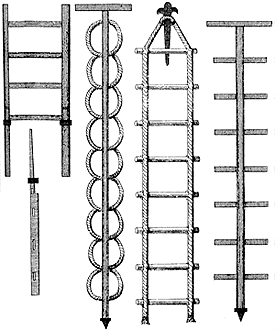 |
Ladders |
 Unless
the breach in the wall was thoroughly blown open and the debris made a convenient
ramp across the ditch and up to the breach (which usually was not the case),
ladders could be required to enable attackers to scale the wall up to the breach
and/or to get down into the ditch and then up the other side - or even daring an
assault without benefit of breach. Ladders were
particularly necessary should the fortification have been
masonry with its steep
walls.
Unless
the breach in the wall was thoroughly blown open and the debris made a convenient
ramp across the ditch and up to the breach (which usually was not the case),
ladders could be required to enable attackers to scale the wall up to the breach
and/or to get down into the ditch and then up the other side - or even daring an
assault without benefit of breach. Ladders were
particularly necessary should the fortification have been
masonry with its steep
walls.
Ladders came in a variety of styles and could be made at the siege site. Some ladders, however, were carried along in the besieger's baggage train. Note the ladder style illustrated at the far left. It's a sectional ladder, with bands that can be moved across the pieces being joined to lock them together.
Scaling the walls with ladders of a fortification was referred to as an "escalade." Attackers could anticipate suffering heavy casualties during an escalade unless surprise was achieved. For over 80 years, Hollywood has made spectacles of the reception defenders provided; a first-had account can be no less startling: "... so soon as he came to the top of the walls, his head was no sooner peeped above the walls, but it seems someone thrust at him with a halberd and thrust off his bever (helmet); his bever was no sooner off but with a sword one struck off his head and fell to the ground, the head being off the body falls upon me and there it lies very heavy upon me and blooded my wonderfully that I was almost smothered with blood." Account by Sydnam Poyntz at the siege of Nördlingen in 1634.